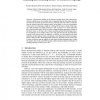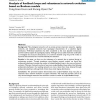200 search results - page 9 / 40 » Degree Distribution of the FKP Network Model |
ICOIN
2007
Springer
14 years 1 months ago
2007
Springer
Measurement studies on the Internet topology show that connectivities of nodes exhibit power–law attribute, but it is apparent that only the degree distribution does not determin...
BMCBI
2007
13 years 7 months ago
2007
Background: Many biological networks such as protein-protein interaction networks, signaling networks, and metabolic networks have topological characteristics of a scale-free degr...
INFOCOM
2010
IEEE
13 years 6 months ago
2010
IEEE
—In this paper, we develop an analytical framework which explains the emergence of superpeer networks on execution of the commercial peer-to-peer bootstrapping protocols by incom...
CAAN
2004
Springer
14 years 26 days ago
2004
Springer
It appeared recently that the classical random graph model used to represent real-world complex networks does not capture their main properties. Since then, various attempts have ...
WAW
2007
Springer
14 years 1 months ago
2007
Springer
Inspired by the recent interest in combining geometry with random graph models, we explore in this paper two generalizations of the random dot product graph model proposed by Kraet...


